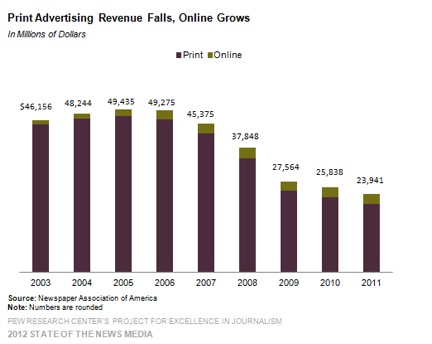We now live in a world defined by disruptive technology and innovation. Venture Capital and Private Equity money is flowing into companies with the next “big” idea that will upend traditional companies. Certainly the magazine and newspaper businesses have been turned on their head by the digital wave. If you don’t believe me, just take a look at this graph provided by the Newspaper Association of America http://bit.ly/wnsFK8:

Advertising revenue is now less than half of what it was in 2006. The demise of print is a perfect example of how new technology can impact traditional income streams.
As someone in advertising and who buys a lot of media on a daily basis, I have kept a finger on the pulse of the television industry, wondering when the pundits will spell their demise as well. We have all heard the predictions. Netflix, Hulu, Apple TV, etc were all the death nail from television as we know it. All have predicted something referred to as “cord cutting” which describes someone who forgoes paid service such as cable or satellite in favor of free Internet video content.
But, so far, the television industry has been phenomenally resistant to this trend. In fact, the TV business model remains very strong. In doing some research, I ran across a study by Needham Insights that gives some very good reasons why any challenger to the TV revenue system will have to battle some stiff headwinds to disrupt the current system:
- TV is actually a good value: Customers pay an average of $75 a month to access 135 channels. Based on viewing habits, the average consumer pays $.30 for every hour they spend in front of TV.
- TV has improved its technology offering: Think DVRs, 3-D, Follow Me TV, HD, Remote Access and expanded service offerings such as security.
- Content: Who do you think funds all of the great shows on TV? Well, you do. The television industry pays huge money in advance for all of the content it delivers. This wasn’t the case in the music industry where consumers could just cherry pick the songs they liked. Now that industry has been severely disrupted.
So, what’s holding the Internet gang back from taking over the TV industry like they did with newspapers and magazines? The primary reason may lie in the quality of the content.
- The free content you find online today is pretty much crap. Yes, it’s fun to surf YouTube videos, but have you ever heard someone schedule their day around a YouTube video?
- QA – Another issue is not only the quality of the content, but the production quality. Much of what you get is poor and cannot compete with the high quality of production offered by the TV industry.
Until the Venture and PE guys find an idea that can reach significant audiences with quality content, TV in its current state is likely to continue to rake in the ad revenue. More importantly, of all the media our Agency buys on behalf of clients, TV usually has the most impact and drives the results. I say this all the time to our clients – Google is where you “Harvest Intent”, but traditional media is still where you create it. I think TV will remain in tact for quite awhile.
[Source: Martin, Laura and Medina, Dan. The Future of TV. Needham Insights. CapKnowledge.com. 22 Jun. 2012. Web. 2 Jul. 2012]
Scott Brandon
Chief Executive Officer
Scott has led the growth of Brandon into a Southeastern powerhouse with over 120 employees in four offices across the U.S. As a highly sought-after strategist and business-minded visionary, he has helped develop and grow brands such as YETI Coolers, Southern Tide, CresCom Bank, Williams Knife Co. and Fish Hippie. Always on the forefront of technology, Scott’s focus is on data-driven marketing and developing growth minded strategies and tactics. Although he has an endless passion for marketing, Scott is happiest when he is outdoors hunting and fishing with his family.
By subscribing to our newsletter, you agree to our Privacy Policy.





